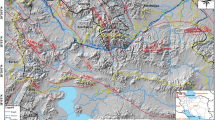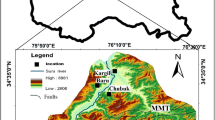Abstract
The Himalayan arc is one of the prominent sites on Earth, for ongoing research on active tectonics because of the frequent occurrence of earthquakes of low-moderate intensity that occur in various sectors of the region. The present study is an attempt to decipher the active uplift and relative tectonic activity in Kosi River basin, a part of the southern Kumaun Himalayas. Several morphotectonic parameters such as asymmetry factor (AF), hypsometric integral (HI), mountain front sinuosity (Smf), channel sinuosity (S), and basin elongation ratio (Re) have been calculated with an objective to compare different sub-basins in the Kosi watershed that may prove useful in deciphering of relative tectonic activity. The watershed delineation of the Kosi River basin as well as its sub-basins, and detailed drainage network has been accomplished by using the CARTOSAT-1 DEM with the help of ArcGIS 10.3 software, using TauDEM tool and Global Mapper 18. Analysis of these morphotectonic parameters reveals that although the whole of the Kosi River basin lies in the seismically active zone, but the northern part along North Almora Thrust (NAT), central part around South Almora Thrust (SAT), Ramgarh Thrust (RT), and southern part along Himalayan Frontal Thrust (HFT) are tectonically more active and undergoing neotectonic rejuvenation. The information derived would prove beneficial in identification of hazard prone areas and in planning of socio-economic development in mountainous terrain.










Similar content being viewed by others
References
Ali Faghih, Nourbakhsh A, Kusky TM (2015) GIS-based analysis of relative tectonic activity along the Kazerun Fault zone, Zagros Mountains, Iran: insights from data mining of Geomorphic Data. J Earth Sci 26(5):712–723
Bull WB, Mc Fadden LD (1977) Tectonic geomorphology north and south of the Garlock fault. California, J Geomorphology 1:15–32
Cox RT (1994) Analysis of drainage-basin symmetry as a rapid technique to identify areas of possible Quaternary tilt-block tectonics: an example from the Mississippi Embayment. Geol Soc Am Bulletin 106:571–581
Farooq S, Sharma I, Khan MN (2015) Geomorphic evidence of active tectonics in eastern Kumaon Himalaya as deciphered from the morphometry of Ramganga River basin. Int J Advancement Earth Environ Sci 3(1):30–39
Gansser A (1964) Geology of the Himalaya. Wiley-Interscience, New York, p 289
Heim A, Gansser A (1939) Central Himalaya. Mem Soc Nat 73:1–245
Jhonson, M. R. W. (1986). The structural evolution of the Kumaun Lesser Himalaya. In current trends in geology. IX Himalayan thrust and associated rocks (Eds. P. S. Saklani). 27-39p
Keller EA, Pinter N (1996) Active tectonics: earthquakes, uplift and landforms. Prentice Hall, New Jersey
Kothyari GC (2014), Morphometric analysis of tectonically active Pindar and Saryu River basins: Central Kumaun Himalaya, Zeitschrift für Geomorphologie, (published online)
Kothyari GC, Pant PD (2008) Evidence of active deformation in the northwestern part of Almora in Kumaun Lesser Himalaya: a geomorphic perspective. Jour Geol Soc Ind 72:353–364
Malik JN, Shah AA, Naik SP, Sahoo S, Okumura K, Parta NR (2014) Active fault study along foothill zone of Kumaun Sub-Himalaya: influence on landscape shaping and drainage evolution. Curr Sci 106(2):229–236
Morisawa M (1985). River - Forms and Process. Longman, London
Mueller JE (1968) An introduction to the hydraulic and topographic sinuosity indexes. Annals Assoc Am Geographers 58(2):371–385
Pant CC, Paul A (2007) Recent trends in seismicity in Uttaranchal. J Geol Soc, India 70(4):619–626
Pathak V, Pant CC, Darmwal GS (2013) Geomorphological and seismological investigations in a part of western Kumaun Himalaya, Uttarakhand, India. Geomorphology 193:81–90
Pike RJ, Wilson SE (1971) Elevation-relief ratio, hypsometric integral and geomorphic area-altitude analysis. Geol Soc Am Bull 82(4):1079–1084
Powar KB (1980) Stratigraphy of Lesser Himalayan sediments of Nainital-Almora area, Kumaun Himalaya. In: Valdiya KS, Bhatia SB (eds) Stratigraphy and correlations of Lesser Himalayan formations, Hindustan Pub. Corp, Delhi, pp 49–58
Saklani, P.S. and Bahuguna, V.K. (1983). Main Central Thrust zone and associated imbricated structures in Chhatera area, Garhwal Himalaya. In: Saklani, P.S. (Ed.), Himalayan Shears, p1–9
Schumm SA, Dumont JF, Holbrook JM (2002) Active tectonics and alluvial rivers. Cambridge University Press, United Kingdom
Schumn SA (1956) Evolution of drainage systems and slopes in badlands at Perth Amboy, New Jersey. Geol Soc Am Bulletin 67(5):597–646
Strahler AN (1952) Hypsometric (area-altitude) analysis of erosional topography. Bull Geol Soc Am 63:1117–1142
Tarboton DG (1997) A new method for the determination of flow directions and contributing areas in grid digital elevation models. Water Resour Res 33(2):309–319
Tarboton DG (1998) Terrain analysis using digital elevation models
Valdiya KS (1980) Geology of the Kumaun Lesser Himalaya: Dehra Dun. Wadia Institute of Himalayan Geology, India
Valdiya KS (1998). Dynamic Himalaya, University Press Hyderabad
Valdiya KS (2001a) Reactivation of terrain-defining boundary thrusts in central sector of the Himalaya: implication. Curr Sci 81(11):1418–1430
Valdiya KS (2001b) Tectonic resurgence of the Mysore plateau and surrounding regions in cratonic Southern India. Curr Sci 81(8):1068–1089
Valdiya KS (2010) The making of India: geodynamic evolution. Macmillan Publishers, India
Acknowledgements
We are thankful to Ministry of Earth Sciences, Govt. of India, for financial assistance under a research project no. (MoES/P.O.(Seismo)1/(212)2013). We are also thankful to Dr. V. Pathak for fruitful discussions and to Mr. Gaurav Kandpal and Mr. Rajesh Lohani for their assistance. We are also thankful to Prof. A.K. Sharma, Head, Department of Geology, Kumaun University, for extending necessary facilities.
Author information
Authors and Affiliations
Corresponding author
Additional information
The present paper is an attempt to understand the ongoing neotectonic activity in the Kosi River watershed in Kumaun Lesser Himalaya, based on evident geomorphological signatures and using remote sensing and GIS technology in deciphering the relative tectonic transformation. Himalaya-Hindukush-Zagros are the parts of same orogen and lie in seismo-tectonically active zone. Thus, we believe that this study would have implications in understanding any of the watersheds in these regions pertaining to ongoing active tectonics.
Rights and permissions
About this article
Cite this article
Pant, C.C., Singh, S.P. Morphotectonic analysis of Kosi River basin in Kumaun Lesser Himalaya: an evidence of neotectonics. Arab J Geosci 10, 421 (2017). https://doi.org/10.1007/s12517-017-3213-8
Received:
Accepted:
Published:
DOI: https://doi.org/10.1007/s12517-017-3213-8




